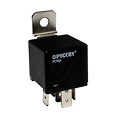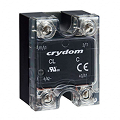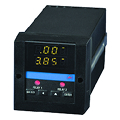Electronic relays are essential components in electrical systems, functioning as electrically controlled switches that manage circuits with consistent reliability. By bridging low-power control signals to high-power loads, relays enable safe, precise, and efficient switching across industries. Shop electronic relays at Online Components for dependable U.S.-based inventory, rapid shipping, and guaranteed in-stock options. Customers choose us for peace of mind, knowing they receive authorized components and straightforward, hassle-free service.
Our electronic relay selection encompasses industry-leading brands such as TE Connectivity, Omron, and Panasonic. Online Components stocks a wide range of electromechanical relays, solid-state relays (SSRs), reed relays, time delay relays, latching relays, and miniature relays. Each type suits different voltages, coil types, switching currents, and mounting configurations. Users can filter products by coil voltage, contact arrangement, switching capacity, or package style to find the best fit for any project. Do you need board-level surface mount devices or heavy-duty panel-mount solutions? We make it easy to find the correct electronic relay for your application. Design engineers, manufacturing purchasers, field maintenance teams, and electronics hobbyists rely on our broad inventory to keep projects and production schedules on track.
Choosing the right electronic relay comes down to several key factors. First, evaluate your load requirements: the voltage and current you need to switch. Using a relay outside its specified range risks performance issues or damage. Next, decide between electromechanical relays and SSRs. Electromechanical relays use physical contacts for switching, offering reliable isolation and audible operation. Solid-state relays use semiconductor technology for faster, quieter, and longer-lasting operation with no moving parts. Consider your operating environment, too. Temperature, humidity, and vibration can significantly impact whether you require a sealed or ruggedized relay for optimal longevity and safety. Careful matching of relay specifications to your project's needs ensures lasting performance and reliability.
Electronic relays play an essential role in several key industries. Industrial automation uses relays to manage motors, pumps, lights, and machine safety interlocks. Automotive systems rely on them for engine control, lighting, and accessory circuits. Building automation employs relays to manage HVAC controls, lighting automation, and access systems. Consumer electronics, ranging from smart home devices to appliances, often incorporate miniature relays for switching and isolation purposes. Critical infrastructure sectors, such as telecommunications and renewable energy, utilize relays to control and protect their equipment.
Source electronic relays from Online Components and gain access to U.S.-based inventory, featuring hundreds of thousands of stock-keeping units (SKUs) available for immediate shipping. Every relay is sourced directly from authorized suppliers, ensuring authenticity and optimal performance. You'll benefit from flat-rate global shipping, quick and knowledgeable customer support, and a seamless online shopping experience. Real-time inventory and transparent pricing eliminate surprises, making it simple to keep your supply chain moving. Ready to upgrade your sourcing experience? Explore our selection of electronic relays and place your order today.
Relays can be categorized into three main types: electromechanical relays (EMRs), solid-state relays (SSRs), and hybrid types. EMRs utilize physical contacts and are well-suited for applications that require isolation and high-load switching. SSRs utilize semiconductor components to switch loads silently, eliminating mechanical wear. Hybrid relays combine both technologies to deliver improved performance for specific applications. Your best choice depends on factors like switching speed, lifetime requirements, noise tolerance, and load type.
The coil voltage rating must match the voltage of your circuit's control signal. Common options include 5V, 12V, or 24V DC, as well as various AC voltages. Using too low a voltage may prevent the relay from activating, while too high a voltage can cause overheating and damage. Factor in the relay's pull-in and drop-out voltages when designing your circuit. Ensure your circuit can supply sufficient current to energize the coil reliably. Always consult the datasheet for exact coil specifications.
Usually, open (NO) contacts stay open when the relay is de-energized and close when activated, allowing current to flow. Closed (NC) contacts work in reverse. They remain closed when the relay is off and open when energized. Select 'NO' or 'NC' based on whether your circuit should be powered by default or only when the relay is activated. Some relays offer multiple contact configurations (such as SPDT or DPDT) for more complex switching requirements. Ensure the contact type matches your circuit's intended behavior.
The contact rating specifies the maximum voltage and current that the relay's contacts can safely switch. Exceeding this rating can cause contact arcing, overheating, or premature failure. Ratings typically cover both resistive and inductive loads. Inductive loads, such as motors, may require derating due to the higher inrush currents they generate. Match the contact rating to your load type and include a safety margin for reliable operation. Review both AC and DC ratings, as they often differ significantly.
Electromechanical relays aren't ideal for high-speed or high-frequency switching due to mechanical limitations and contact bounce. Solid-state relays work better for these applications, offering faster response times and longer service life. For rapid cycling or pulse switching, verify the relay's switching speed and recommended duty cycle. In some cases, MOSFET or transistor-based switching solutions may be more suitable. Always select relays rated for your design's switching frequency and operational requirements.
Yes, but check each relay's ratings first. Some work specifically with AC loads, some with DC, and others can switch between. Refer to the product datasheet for compatibility information with your application.
Absolutely. Relays are often chosen to control high-power devices such as motors, heaters, and large lighting systems. Choose a relay with ratings that meet or exceed your switching current and voltage needs for safe and reliable operation.
See More




